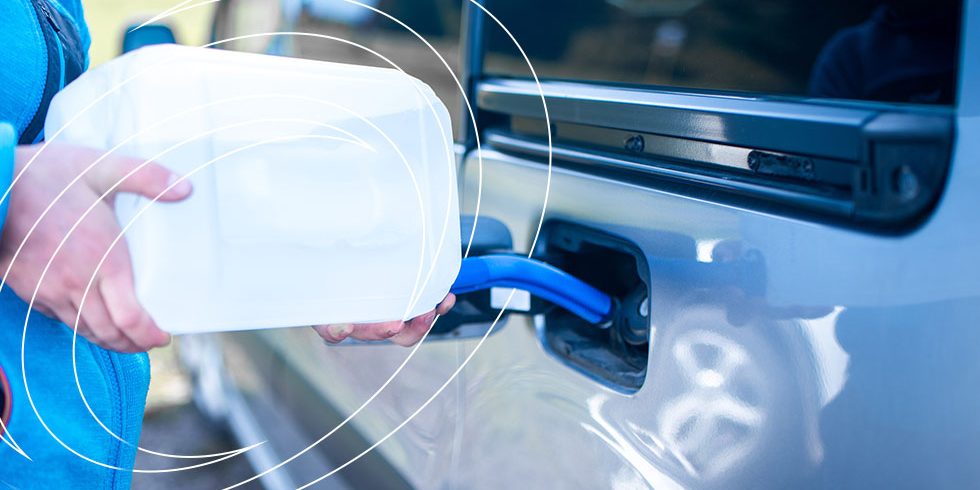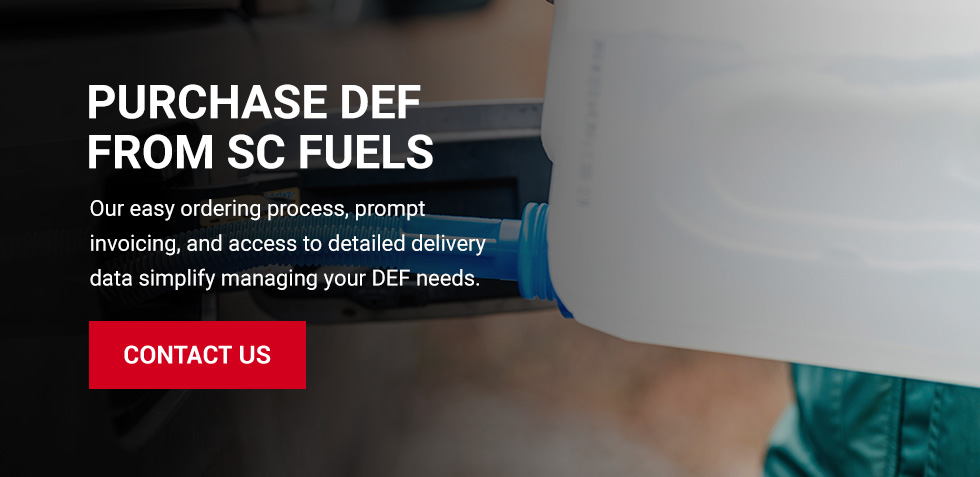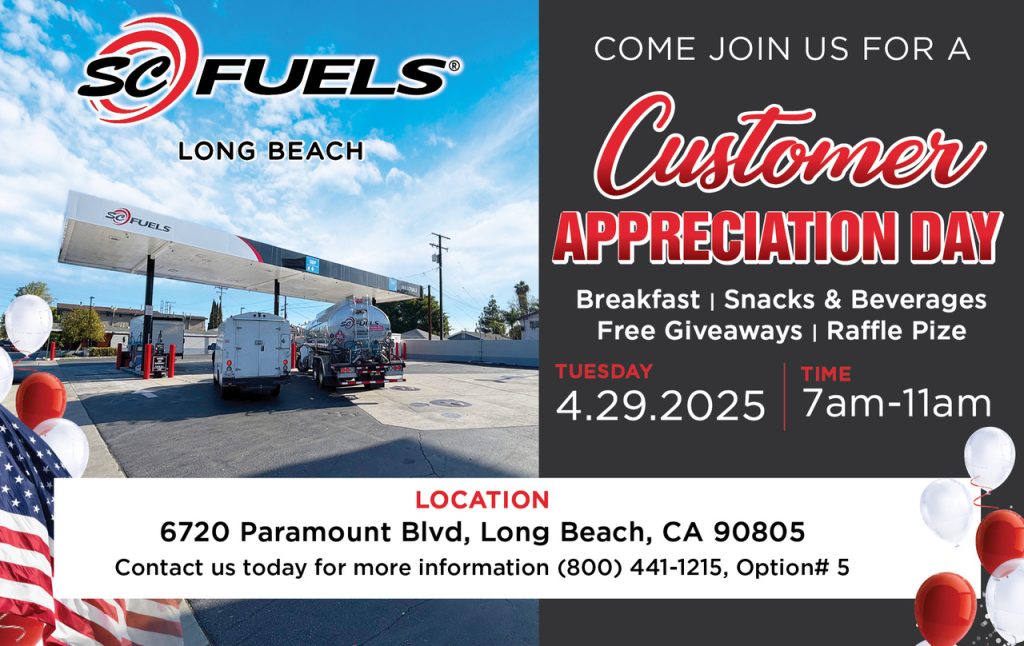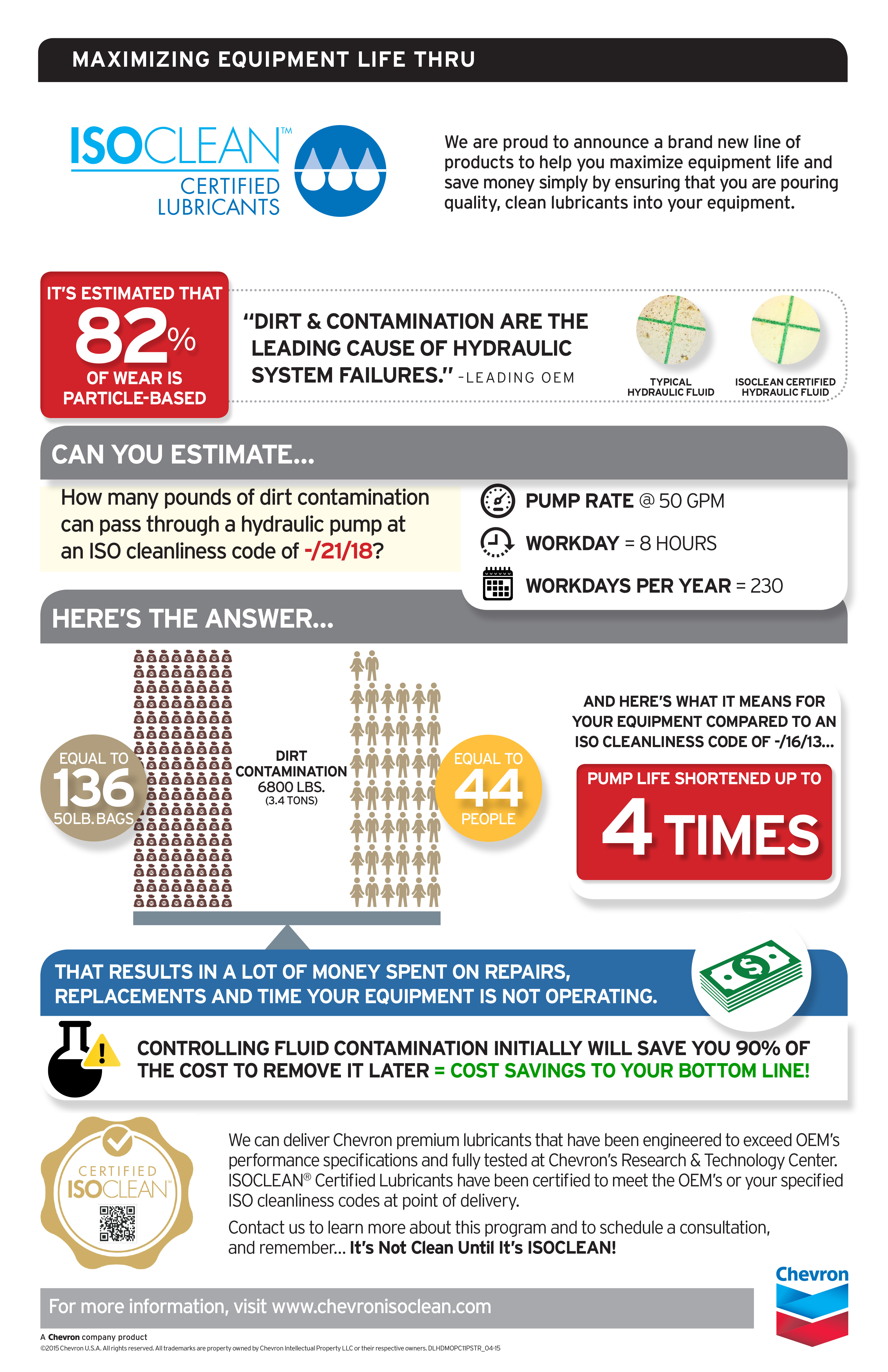If you own a fleet of vehicles or manage a trucking company, you know that staying on top of maintenance and compliance is crucial for daily operations.
With diesel engines supporting heavy-duty transportation, you want to ensure they meet emissions standards and performance. DEF stands for diesel exhaust fluid and can help you meet those regulations and keep your operations on track. The fluid reduces pollutant emissions and may help you stay compliant, regulate fuel consumption, and improve the life span of your engine.
Learn what DEF is, what it is made of, and how it may impact your workflow.
What Is DEF?
DEF is a liquid solution that helps reduce nitrogen oxide (NOx) emissions, a pollutant created during the combustion process in diesel engines. It keeps diesel vehicles operating within the environmental standards the Environmental Protection Agency (EPA) set by working in tandem with Selective Catalytic Reduction (SCR) systems.
What Is Selective Catalytic Reduction?
SCR is an emissions control technology that helps reduce harmful NOx emissions diesel engines produce. Manufacturers integrate the SCR system into a vehicle’s exhaust system. Here is an overview of how the DEF chemical reaction occurs within SCR:
- Exhaust gases leave the engine, and DEF is injected.
- DEF reacts with NOx and breaks down into ammonia.
- The ammonia reacts with NOx gases and turns to water vapor and nitrogen.
- Nitrogen and water vapor get released into the environment.
What Is Diesel Exhaust Fluid Used For?
DEF is used to break down NOx gases produced during diesel combustion. The liquid reduces harmful nitrogen oxide emissions. These emissions contribute to air pollution, smog formation, acid rain, and respiratory problems. DEF promotes cleaner and more efficient operations for modern diesel vehicles. Diesel engines can convert these harmful gases into nitrogen and water vapor.
DEF is commonly used in diesel-powered vehicles, but its applications extend to other industries. Construction equipment and agricultural machinery use SCR systems that rely on DEF.
What Is DEF Made Of?
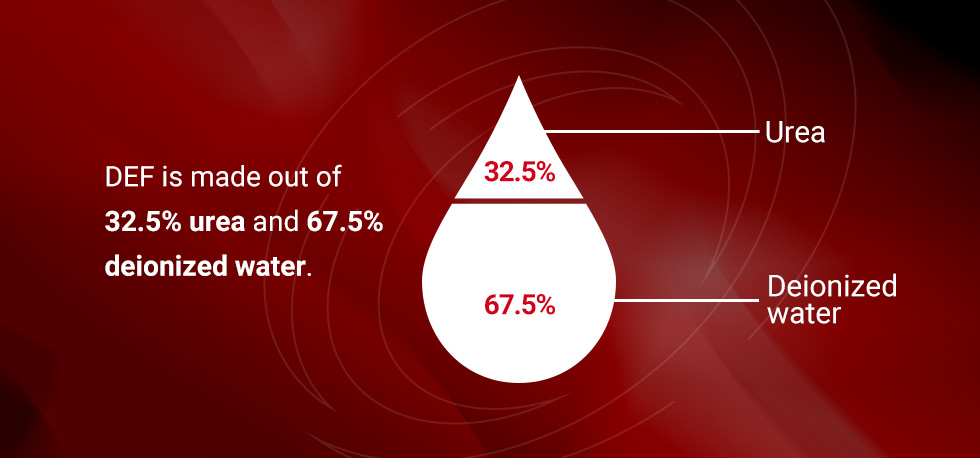
DEF is made out of 32.5% urea and 67.5% deionized water. This composition contributes to the clean running of modern diesel engines. Here is how these ingredients help meet EPA regulations.
Urea
Urea is the active ingredient in DEF. It is not the same as natural urea found in animal waste but a synthetically produced compound made for industrial use. Industrial-grade urea is pure and prevents introducing contaminants into your engine’s exhaust system. When infused into the exhaust steam, urea undergoes a chemical reaction. It decomposes to produce ammonia (NH3), which interacts with nitrogen oxide in the SCR catalyst to form nitrogen (N2) and water (H20).
Deionized Water
Deionized water is purified water that serves as the carrier so the solution can flow through the engine’s exhaust system and react in the SCR process. Regular water contains minerals that can damage the SCR system. Deionized water is free from these contaminants, so the solution remains stable and does not clog or corrode the exhaust system’s components.
What Does DEF Do for Diesel Engines?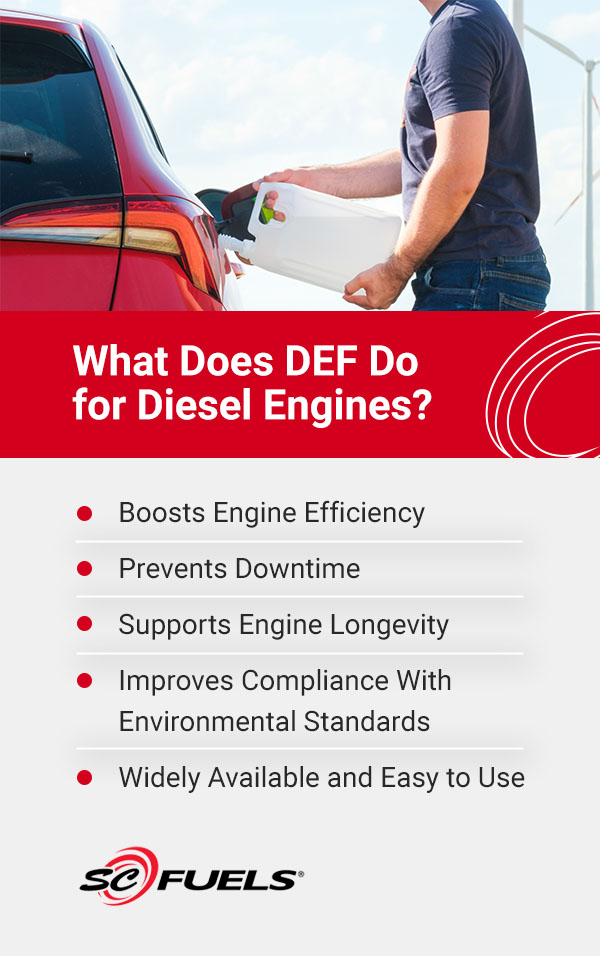
DEF interacts with your vehicle’s engine exhaust as part of an after-treatment process. After diesel fuel burns in the engine, exhaust gases containing NOx get neutralized. Here are the benefits of DEF for diesel vehicles.
Boosts Engine Efficiency
Before SCR systems and DEF became standard, emissions control methods, like exhaust gas recirculation, required engines to operate at lower combustion temperatures to reduce NOx production. This approach often reduced fuel efficiency and engine power. With the DEF and SCR technology, diesel engines may operate at optimum combustion temperatures.
This means:
- Better fuel economy: Optimum combustion temperatures may result in more complete fuel combustion, which reduces fuel consumption.
- Increased power output: Engines can deliver optimal performance without compromising emissions standards.
Prevents Downtime
For fleet owners, downtime can be an expensive challenge to manage. DEF helps avoid this by ensuring that vehicles with SCR systems remain operational. When DEF levels are too low, the system alerts the operator to refill before the vehicle’s performance lowers or shuts down completely. These alerts make it easier for drivers to have a steady supply of DEF to minimize disruptions.
Supports Engine Longevity
Diesel engines are durable and have long life spans, but introducing SCR systems and emissions-reducing DEF might further extend their potential. Here is how DEF contributes to engine longevity:
- Reduces soot and carbon deposits: Because DEF allows engines to burn fuel more efficiently, it indirectly reduces the buildup of soot and carbon inside the engine. This leads to cleaner components and less wear and tear.
- Lower exhaust temperatures: The SCR system reduces the workload on other emissions-control components. This results in lower exhaust temperatures and less stress on the system.
- Minimize risk of damage: DEF’s purity level may prevent contaminants from entering the exhaust system to protect sensitive components.
Improves Compliance With Environmental Standards
Governments worldwide have introduced tight emission standards to reduce air pollution. Without DEF, vehicles with SCR systems cannot operate efficiently or legally. For fleet operators, noncompliance can lead to hefty fines or loss of operating permits. DEF provides a straightforward solution for meeting these regulations. Staying compliant helps prevent fines and supports long-term sustainability.
Widely Available and Easy to Use
DEF is widely available at fuel stations and automotive supply stores. For fleet operators, services like SC fuels can simplify the process by offering bulk DEF delivery so you have a steady supply to keep your trucks running and reduce the hassle of managing inventory. Its standardized formula makes it compatible with most modern diesel engines. The tanks are designed for easy refilling, with clear indicators and user-friendly nozzles to prevent spills.
When Was DEF Required?
The Environmental Protection Agency (EPA) introduced DEF to address and reduce the harmful emissions of diesel engines in 2010. The EPA and other regulatory bodies imposed tighter standards for NOx emissions and particulate matter from heavy-duty trucks and diesel-powered vehicles. The EPA phased in these regulations with newer trucks — those built after 2010 — needing to comply with these limits.
These standards aimed to curb diesel engines’ contribution to air pollution. The regulations were part of an initiative to improve air quality, public well-being, and the environment.
As part of these new emissions standards, manufacturers adopted SCR technology, which relies on DEF to help reduce NOx emissions. 2010 marked the formal introduction of DEF requirements in the U.S., but the use of DEF spread internationally. Other countries adopted similar emissions standards for heavy-duty diesel vehicles.
How Does a DEF System Work?
The DEF system works through a process of integration of technology and chemistry. Before explaining how the system works, it is helpful to understand its main components and how each facilitates the reactions that reduce emissions:
- DEF tank: This is where the DEF is stored. These tanks can keep the fluid at optimal temperatures to prevent degradation.
- DEF pump and injector: The pump draws DEF from the tank and sends it to the injector, which delivers the right amount of DEF into the exhaust stream.
- SCR catalyst: A chamber where chemical reactions occur and break down NOx gases.
- Control system: The system’s electronic component that monitors DEF levels.
As diesel fuel burns in the engine, it produces exhaust gases. Before these gases exit through the tailpipe, DEF gets infused into the exhaust stream. DEF works by interacting with the temperatures in the exhaust system and decomposes into ammonia and carbon dioxide.
The ammonia reacts with the NOx gases in the SCR catalyst. This reaction breaks down the NOx molecules into nitrogen, which makes up most of the air we breathe, and water vapor. After the SCR process, the system releases neutralized gases into the environment. By the time exhaust exits in the tailpipe, DEF will have neutralized most of the emissions.
The amount of DEF injected depends on the following factors:
- Engine load: Heavier loads may require more power. This may lead to higher NOx emissions and may require more DEF.
- Exhaust flow rate: Faster exhaust flow during high-speed operations may require quicker DEF injection.
- Operating conditions: Temperature may affect how the DEF system functions. DEF freezes at 12 degrees Fahrenheit — -11 degrees Celsius. To counteract this and prevent clogging, DEF tanks have heating elements that thaw the fluid as the engine warms up.
If DEF levels drop too low, the engine control system will alert the driver through dashboard warnings. Modern diesel engines can enter limp mode or derate mode to limit power and speed and prevent excessive emissions.
How to Manage a DEF System
SCR and DEF are apt at DEF offsetting harmful emissions, but they may experience the following operational challenges:
- Freezing: Although some DEF systems have heaters to thaw the fluid, freezing may still delay operations if operators do not take proper precautions.
- Contamination: DEF is sensitive to impurities. Dirt, fuel, or other contaminants can compromise its effectiveness and may damage the SCR system.
- Storage and shelf life: If stored correctly, DEF has a shelf life of one to two years. However, exposure to high temperatures, direct sunlight, or contaminated storage containers can reduce its effectiveness.
Here are some practices fleet owners can implement to maximize DEF’s efficacy:
- Invest in proper storage: Use dedicated storage tanks or containers to prevent contamination. Keep storage areas cool, shaded, and clean to maintain the fluid’s integrity. Regularly inspect large tanks for leaks, contamination, or signs of aging.
- Monitor and maintain DEF levels: Always check the dashboard to track DEF levels and alert drivers before tanks run low.
- Train drivers and technicians: Educate drivers and technicians on reading DEF gauges and responding to low-level warnings. Emphasize potential issues that may arise when using contaminated DEF or substituting it with other liquids.
- Winterize the fleet: For fleets operating in colder climates, check that all vehicles have functional DEF heating systems. Store the liquid indoors or in insulated tanks to protect it from extreme temperatures during transit or refilling.
- Source high-quality DEF: Partner with supplies like SC Fuels for consistent access to high-quality DEF, ideally one that meets ISO 22241 standards. Avoid buying from unverified sources to reduce the risk of substandard products.
Frequently Asked Questions About DEF
Here are answers to some of the most frequently asked DEF-related questions.
What Is Blue DEF?
Blue DEF is a branding name used in Germany to refer to DEF. Despite the name, DEF is a colorless liquid. The term Blue typically shows its association with the German Association of the Automotive Industry (VDA).
How Often Should You Add Diesel Exhaust Fluid?
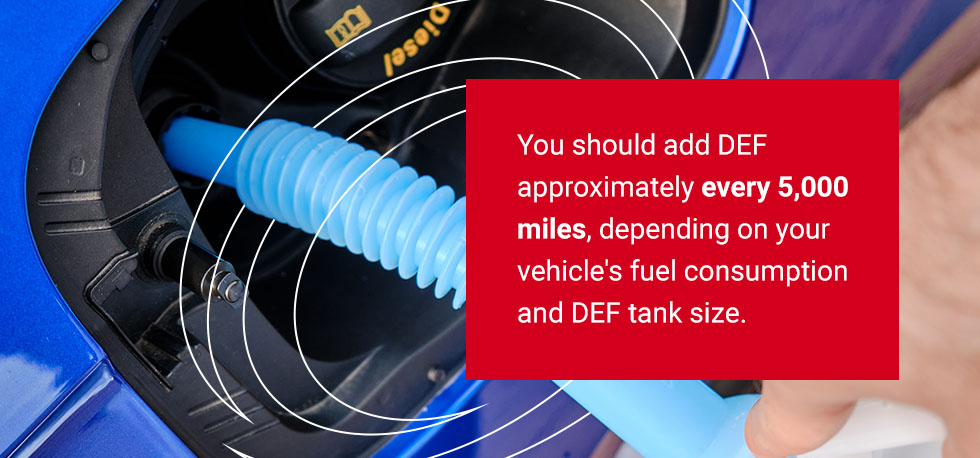
You should add DEF approximately every 5,000 miles, depending on your vehicle’s fuel consumption and DEF tank size.
Can You Use Water for DEF?
No, water cannot be substituted for DEF. DEF contains deionized water and urea, which is crucial for the chemical reaction that neutralizes NOx emissions. Using water can damage the SCR system and void the engine’s warranty.
What Is a Substitute for DEF Fluid?
There are no suitable substitutes for DEF. DEF is a specific mixture of urea and deionized water, and it is the only fluid that can trigger a chemical reaction in the system. Using a different liquid can damage the engine and SCR components.
What Happens When You Run Out of Diesel Exhaust Fluid?
When the DEF tank is empty, the vehicle’s SCR system cannot reduce NOx emissions, and the engine may experience a power reduction. Modern trucks often have sensors that monitor DEF levels and provide alerts so you can refill the tank before it runs dry. If the DEF is completely depleted, your engine may be prevented from starting until you refill the fluid.
Does DEF Expire?
DEF does expire. Under proper storage conditions, DEF can last up to two years if unopened and stored at ideal temperatures or one year if opened. Always check the expiration date on the container and avoid using expired or contaminated DEF to prevent system issues.
Where Can I Buy DEF?
DEF is available at SC Fuels. We provide businesses with high-quality DEF and bulk delivery services. Our team can help you understand your operation’s DEF needs and be your trustworthy fuel partner.
Purchase DEF From SC Fuels
SC Fuels provides reliable fuel solutions for fleet operations, diesel vehicle owners, and gas station owners. Whether you are managing a large fleet or a growing business, we are here to simplify the process with reliable bulk delivery, competitive pricing, and exceptional service.
We provide DEF across the West Coast and Southwest regions. Our easy ordering process, prompt invoicing, and access to detailed delivery data simplify managing your DEF needs. With access to your account, you can track your orders and monitor costs.

